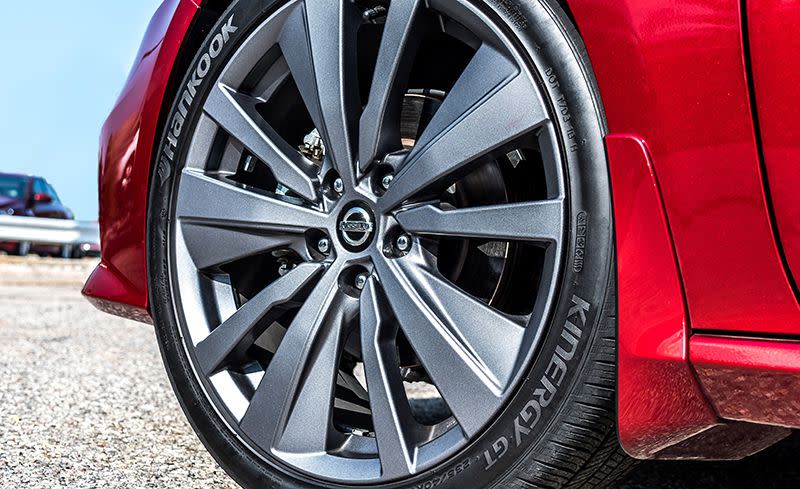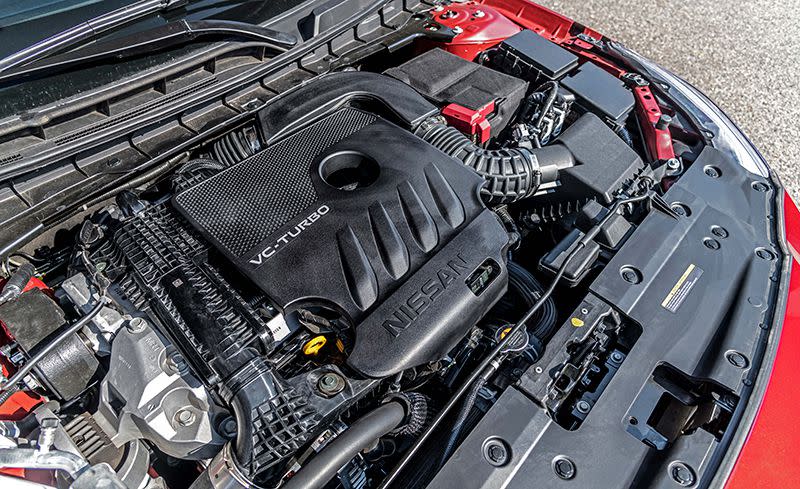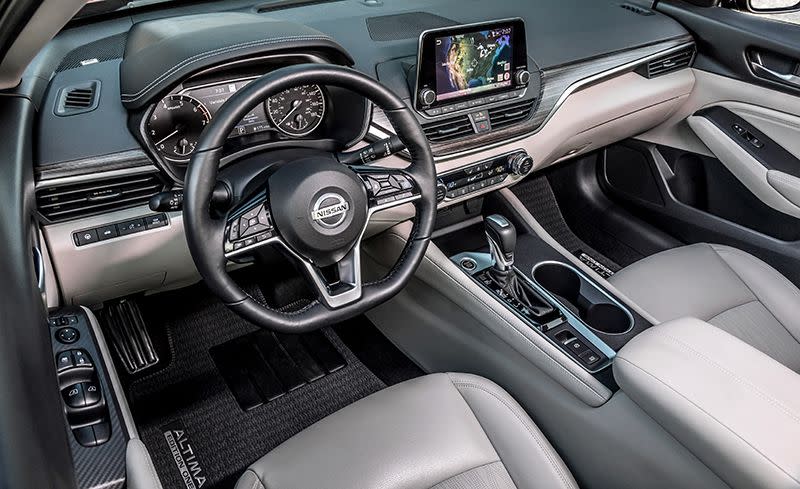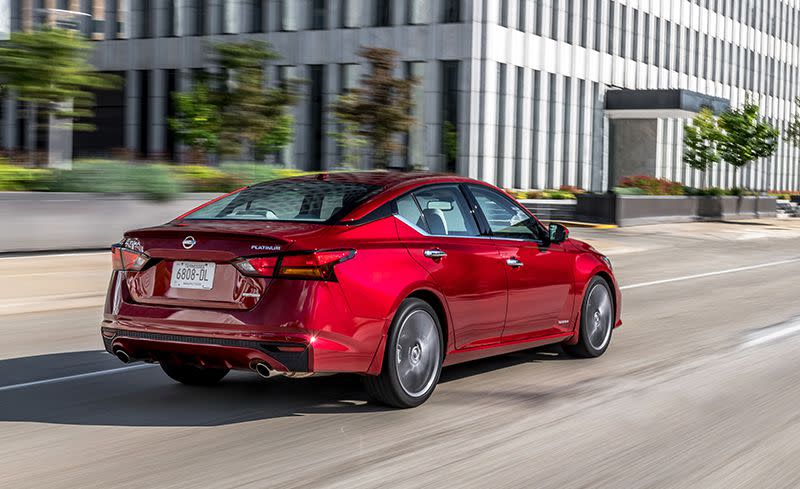The 2019 Nissan Altima 2.0T Is Packing Heat
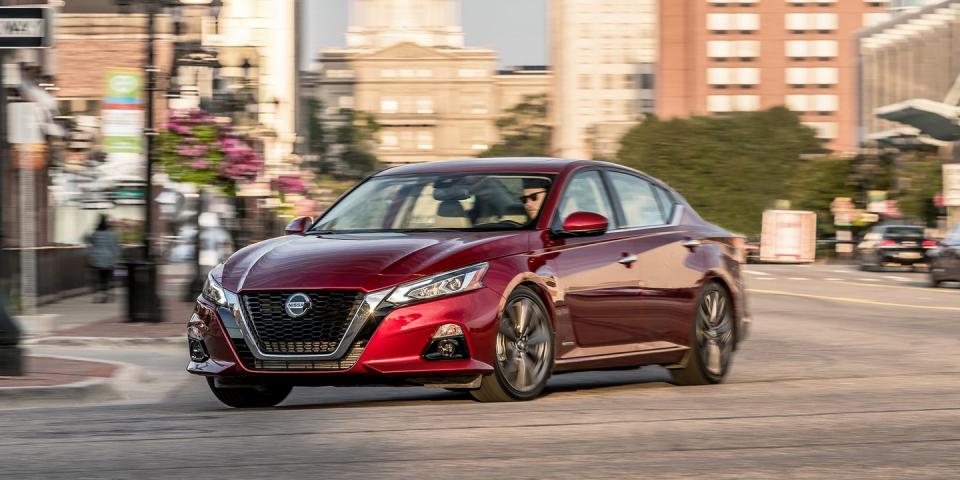
As ideas go, this one might not make automotive history, but it's the kind of thing we think about between rounds of office Plinko. Nissan could have executed the most accurate and brilliant car-branding plot in history when it named its sedans. Consider this: After the introduction of its big car, the Maxima, in 1981, a natural next step would have been to call its new small sedan for 1982 the Minima. Without consulting us, Nissan named it the Sentra. Ten years later, when the company trotted out its revised mid-size sedan, it could have completed the trifecta by calling it the Media. Minima, Media, and Maxima are names so easy to remember that even Motor Trend could do it.
But it was not to be. Nissan's mid-size car is the Altima. Has been since 1992, during which time Nissan dealers have unloaded some 5.6 million of them. Nissan sold more than a quarter-million Altimas in 2017, and the car ranks third in sales among mid-size sedans through August 2018. While it continues to lose ground to the Rogue, the Altima still accounts for more than 17 percent of the company's total U.S. sales. So this fully redesigned model, the sixth generation of the middle man, matters a lot.
We don't care how many it sells, because popularity and desirability converge on the same car with Hale-Bopp rarity. But that just happens to be the exact dilemma facing Nissan. Honda's Accord not only outsells the Altima, it made our 2018 10Best list-and 31 10Best lists before that, more appearances than any other car. That it's the standard bearer in the class is clear. That Nissan has the savvy required to displace it is less so. "There's nothing grievously wrong with the Altima . . . We just wish there were more right with it," we said in a tepid review of the 2018 model.
Yet, when this Scarlet Ember-okay, it's red-sedan rolled in to C/D HQ, we stood up. Its tapered nose, trapezoidal grille, and 19-inch wheels triggered emotions not usually activated by cars in the appliance class. This, at least, is a proper-looking sedan.
SR and Platinum trims offer Nissan's most recent engineering achievement. The KR20DDET inline-four in our Platinum test car is a turbocharged 2.0-liter capable of varying its compression ratio from 8.0:1 to 14.0:1. Due to a revised engine calibration, its 248 horsepower is down 20 from the version in the 2019 Infiniti QX50, where this engine made its debut. Torque remains the same, though, at 280 pound-feet. The VC-Turbo's party trick is the ability to cruise at high-compression ratios for efficiency then switch to the knock resistance of a low-compression engine under load, allowing for greater boost levels. A CVT driving the front wheels is the only transmission available with the turbocharged powerplant, and in SR trims, it comes with paddle shifters.
The EPA says the Altima is good for 29 mpg combined, 3 mpg better than last year's V-6–powered model and topping the turbocharged 2.0-liter 10-speed Accord EX-L by 2 mpg. Otherwise, all five trims come standard with a new 2.5-liter four-cylinder good for 188 horsepower and 180 pound-feet of torque. Front-wheel drive and a CVT are standard, but the all-wheel-drive system available with the 2.5-liter is a segment rarity.
Innovative powertrains alone do not make a winning mid-size sedan, however. In this class, the minutiae separate good from great. It's the Accord's all-encompassing richness and low-stress demeanor that make it a favorite. Nissan knows this, which is why it streamlined the Altima's HVAC controls, positioned its 8.0-inch infotainment screen higher on the dash, retained the all-day-comfortable seats, and gave it a small-diameter thick-rimmed steering wheel. It's a modern, functional presentation that doesn't pretend to be a luxury car but also doesn't saddle drivers with goofy gimmicks such as a push-button shifter. Materials in our top-trim model were nice enough, but the fake wood on the dash will fool no one.
Maybe it won't need to. There are so many other things to like about the Altima, starting with its roominess. Jam them into some cars in this class and our biggest staffers look like Bowser in Mario Kart. But here, with the front seat adjusted for their own driving positions, six-and-a-half-footers fit comfortably in the back. The rear quarters are big enough that almost everyone will be comfortable, but they do lack the startling airiness of the Accord's.
Our test car surged to 60 mph in 5.9 seconds, quicker than many buyers in this class will ever care to travel. But it is a few tenths less rapid than the last 2.0-liter 10-speed Accord we tested, which also retained its lead through the quarter-mile. The Altima's CVT lacks the immediacy and control offered by the Accord's transmission-especially in the Nissan's Platinum trim, which lacks paddle shifters. And there's no denying the wind-up effect at wide-open throttle, a product of the combined delays of building boost and a CVT changing ratios. Sport mode sharpens throttle response by holding the engine about 500 rpm higher, which you'll only notice if you're paying attention. But adequate low-rpm torque is the cure for CVT drone, and the Altima has it. It's quick enough that you'll not be burdened by that old gripe for more than a couple seconds at a time. Truth is, all but the most ardent CVT haters will find this to be a perfectly competent and exceedingly smooth transmission.
We like the Altima's accurate, controlled handling despite the fact that it's helicopter-parented by multiple electronic aids. Nissan's Intelligent Trace Control smoothly applies braking force to individual wheels to help the car follow the driver's chosen path. Technically, it's a function of the stability-control system, but unlike so many of those, it works behind the scenes. Speed-sensitive steering ramps up effort with pace, is amply precise, and doesn't fall into the trap of some other Nissan products, which substitute effort for feel. No mid-size sedan we've tested recently can match its 0.91-g stranglehold on the skidpad, a feat it accomplished on big, if modest, 235/40R-19 Hankook Kinergy GT all-season tires. Even without the more aggressive suspension tune of the SR, which brings 10 percent stiffer springs and dampers to match, the Platinum is proficient at cornering speeds that will only be asked of a car like this if its keys are proffered over the battered Formica of a rental counter. The Altima sticks comfortably even on the most cratered of southern Michigan's roads, the suspension vectoring it ably through bends without a commensurate penalty in ride quality. Braking is competent and predictable, though at 172 feet from 70 mph to zero, it's only midpack.
A big part of the Altima's sales pitch is its tech package, which is led by ProPilot Assist. Nissan's initial foray into semiautomated driver assistance, ProPilot Assist starts with adaptive cruise control and then adds steering assistance with the goal of keeping the Altima centered in its lane. It will bring the sedan to a complete stop in traffic and resume forward motion with the touch of a button. We found it most useful in stop-and-go driving, rather than faster-moving environs where the steering assist's constant pull was distracting. ProPilot is standard on the top three trims (SV, SL, and Platinum). Lane-departure warning and rear automated braking, which applies the brakes if it senses an imminent collision while the car is reversing, also come on those trims.
Automated emergency braking and forward-collision warning are standard on every Altima. Rear-cross-traffic alert and blind-spot monitoring are included on all but the base S models. It's a load of tech, much of which is still new in this segment, and at times it feels as if Nissan has successfully toppled Toyota as King of Beep and Vibrate. Most of these aids can be configured or disabled through menus in the instrument panel, and the settings stick across key cycles. But as a reminder that the Altima's tech overlords were always with us, every time we turned onto a gravel road, a robo voice warned, "Caution: unpaved road." Other master-of-the-obvious alerts include flood, construction, and restricted-road warnings. This SiriusXM Traffic–based feature is one you'll pay for on SL and Platinum grades only so you can disable it immediately.
Our Platinum example was an Edition One, which adds exclusive wheels, bric-a-brac like floor mats and illuminated sill plates, and, more usefully, three years of concierge service. It tallied at $36,645. That it's $50 cheaper than a top-trim 2018 Honda Accord Touring says that Nissan believes buyers will find Accord-like value in the new Altima. We agree. This is a strong effort, a striking sedan with enough grace to be considered alongside the segment leader, enough room to be on the radar of buyers still considering sedans, and enough technology to carry it through this model cycle. If only Nissan had given it the right name.
Competitors
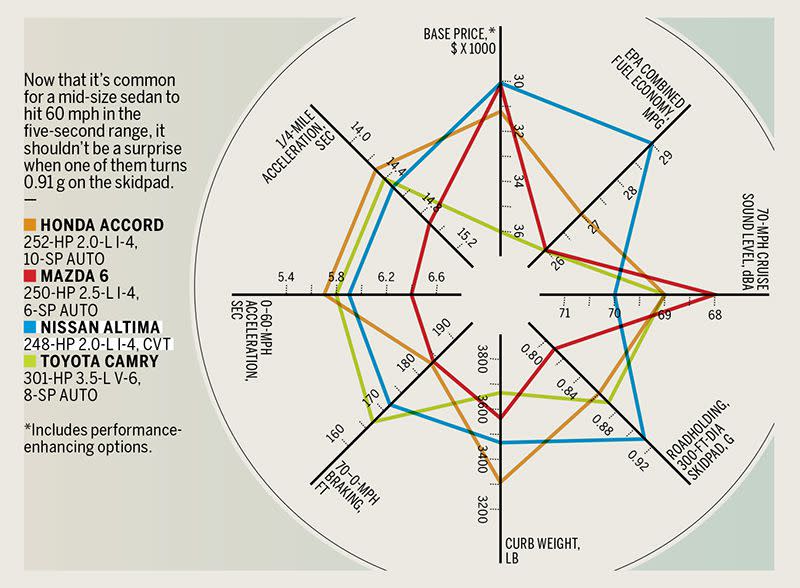
From the November 2018 issue
('You Might Also Like',)

 Yahoo Autos
Yahoo Autos 